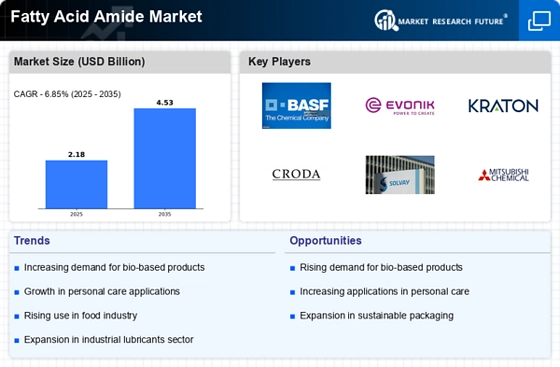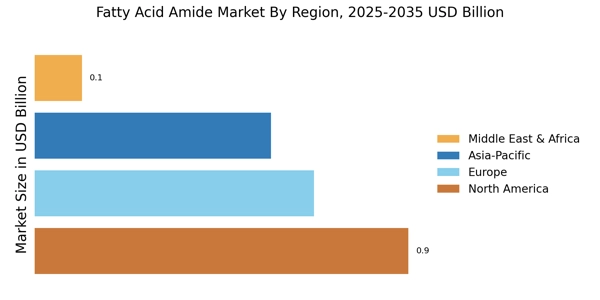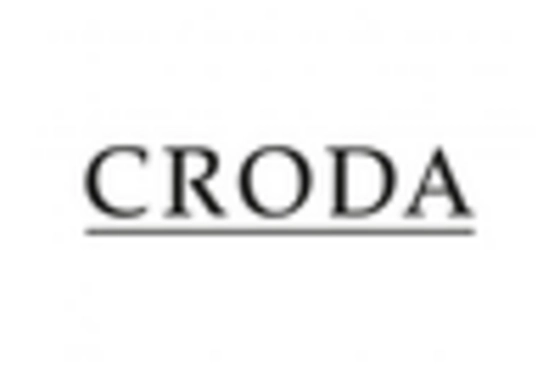Regulatory Support
Regulatory frameworks are increasingly supporting the growth of the Fatty Acid Amide Market. Governments are implementing policies that encourage the use of bio-based and environmentally friendly chemicals, which aligns with the properties of fatty acid amides. This regulatory support is fostering innovation and investment in the sector, as companies seek to comply with stringent environmental standards. Additionally, the promotion of green chemistry initiatives is likely to enhance the market's appeal to manufacturers and consumers alike. As regulations continue to evolve, the Fatty Acid Amide Market is expected to benefit from increased demand for compliant products, further propelling market growth.
Technological Innovations
Technological advancements are playing a pivotal role in the evolution of the Fatty Acid Amide Market. Innovations in production processes, such as the development of more efficient synthesis methods, are enhancing product quality and reducing costs. For instance, the introduction of green chemistry techniques is enabling manufacturers to produce fatty acid amides with lower environmental impact. Furthermore, advancements in analytical techniques are facilitating better quality control and product development. The market is witnessing a surge in research and development activities aimed at creating novel fatty acid amides with enhanced properties. This technological progress is likely to drive growth in the Fatty Acid Amide Market, as companies strive to meet the evolving needs of consumers and industries alike.
Sustainability Initiatives
The increasing emphasis on sustainability within the Fatty Acid Amide Market is driving demand for eco-friendly products. Manufacturers are increasingly adopting sustainable practices, such as sourcing raw materials from renewable resources. This shift is not merely a trend but a response to consumer preferences for environmentally responsible products. As a result, companies that prioritize sustainability are likely to gain a competitive edge. The market for fatty acid amides is projected to grow at a compound annual growth rate of approximately 5.2% over the next few years, indicating a robust demand for sustainable solutions. This focus on sustainability is expected to shape the future landscape of the Fatty Acid Amide Market, influencing product development and marketing strategies.
Diverse Industrial Applications
The versatility of fatty acid amides is a key driver in the Fatty Acid Amide Market. These compounds find applications across various sectors, including personal care, agriculture, and plastics. In the personal care industry, fatty acid amides are utilized as emulsifiers and surfactants, enhancing product performance. In agriculture, they serve as adjuvants, improving the efficacy of pesticides and herbicides. The plastics industry employs fatty acid amides as processing aids, contributing to improved product characteristics. This broad range of applications is expected to sustain demand, with the market projected to reach a valuation of approximately USD 1.5 billion by 2027. The diverse industrial applications of fatty acid amides are likely to continue driving growth in the Fatty Acid Amide Market.
Rising Demand in Emerging Economies
Emerging economies are witnessing a surge in demand for fatty acid amides, significantly impacting the Fatty Acid Amide Market. As these regions experience economic growth, there is an increasing need for personal care products, agricultural chemicals, and industrial applications that utilize fatty acid amides. The expanding middle class in these economies is driving consumer spending on personal care and household products, which often contain fatty acid amides. Furthermore, the agricultural sector in emerging markets is evolving, with a growing focus on sustainable practices that incorporate fatty acid amides. This rising demand is expected to contribute to a robust growth trajectory for the Fatty Acid Amide Market, as companies seek to capitalize on opportunities in these developing regions.


















Leave a Comment